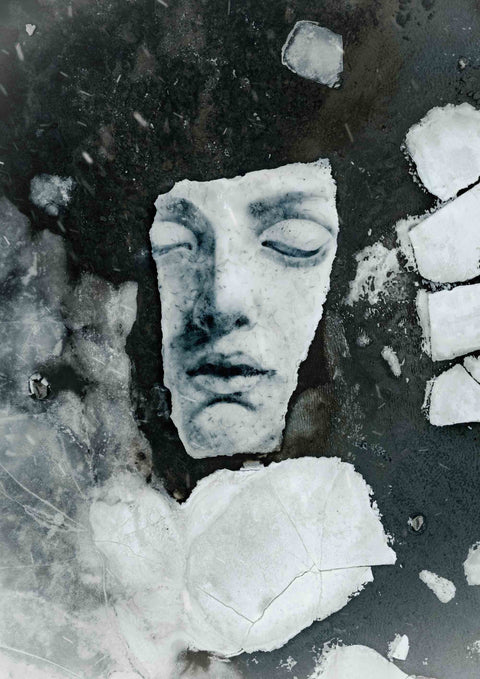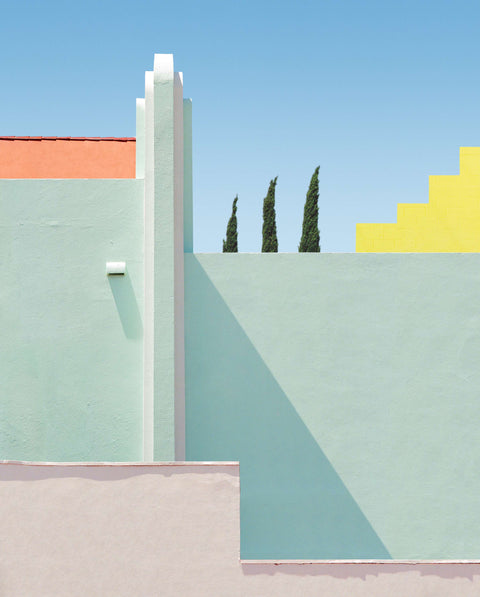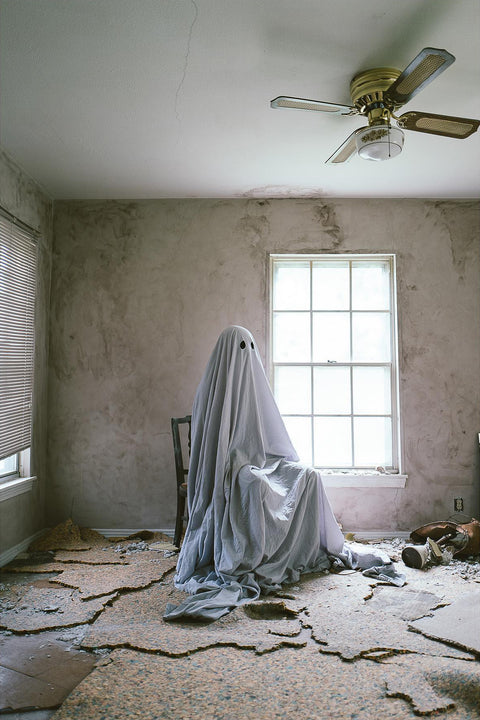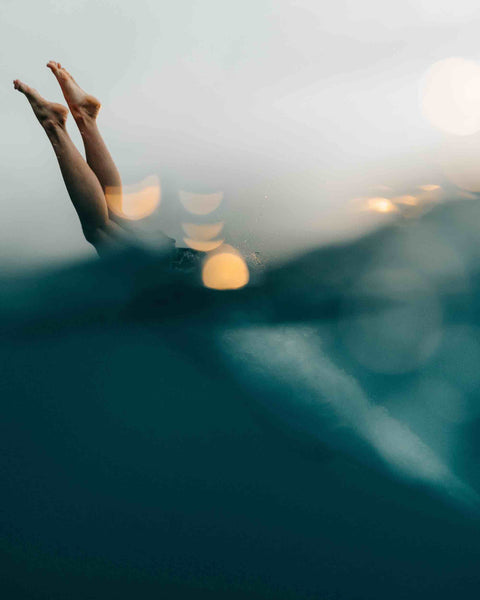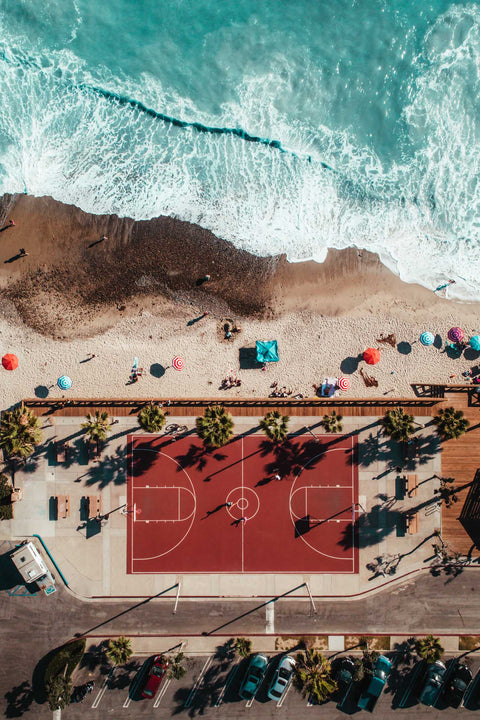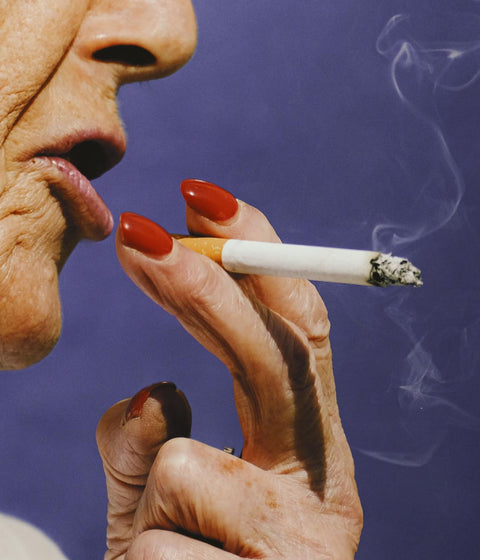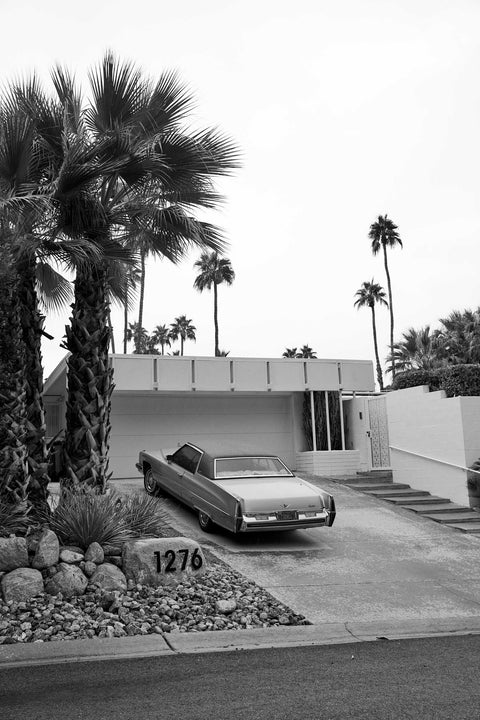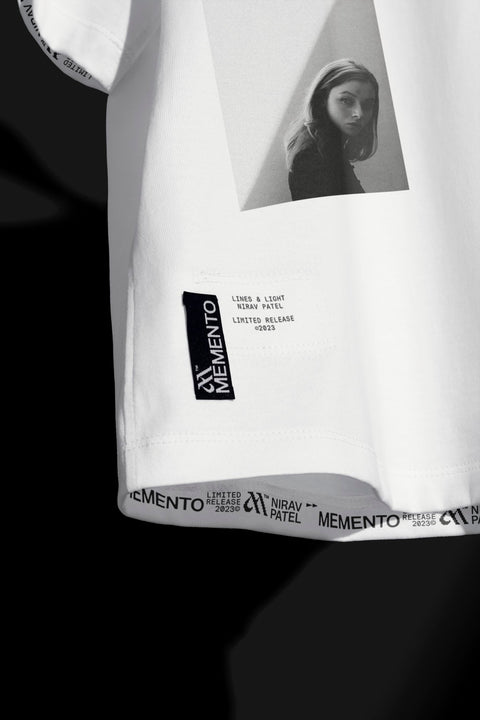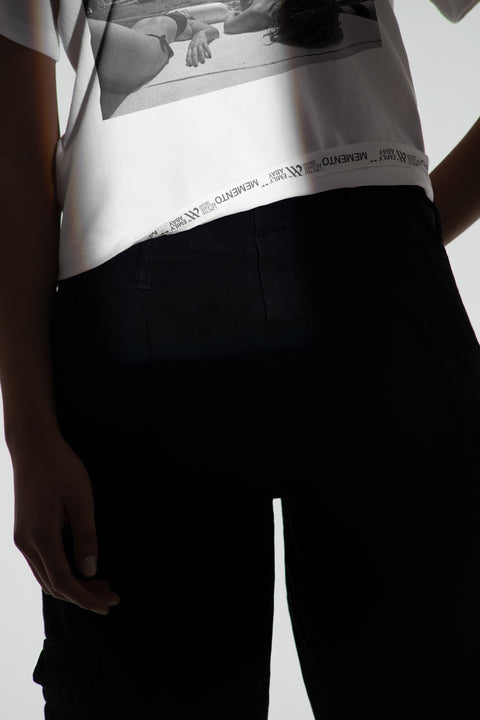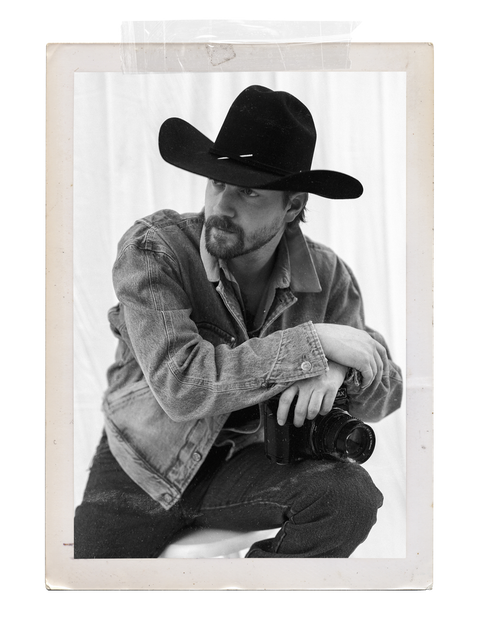
Beau Simmons
On a -16 windchill drive between ranches in Western Montana, Memento spoke with Beau about his background as a fashion and fine art photographer. Beau shared the stories behind each image and discussed his views on the intersection of fashion and photography.

You recently released a short film documentary about your background as a photographer, could you summarize the key highlights here for our readers about how you got started in photography?
I've been a photographer for almost 18 years now and I started at the age of 16 when my family and I took a little trip to Hawaii. Along that trip I brought one of those old Nikon little cameras with me and became obsessed with taking photos of local scenery like the waterfalls, the palm trees and sunsets on the beaches.

“During that time, I was working retail and I was barely making minimum wage and so I kind of went all in. I dropped out of school after four months, thinking that I wanted to go to film school and learn how to direct movies in Hollywood.”
For a few years I just started casually taking photos and then around the age of 21, I started taking photos of friends while going out camping and producing that backpacking lifestyle kind of outdoor stuff. And then I had a company called Aeropostale reach out and wanted to book me for a campaign to shoot. It was the most money I've ever seen written on a check when I got it a month later. And I think from there I kind of realized that I was onto something and that I had a career here.
During that time, I was working retail and I was barely making minimum wage and so I kind of went all in. I dropped out of school after four months, thinking that I wanted to go to film school and learn how to direct movies in Hollywood. And it kind of came to the point where I just realized that my passion was photography.
So then I left film school after four months and then pursued the fashion industry, which went on for nearly 10 years. That garnered me clients like Mark Jacobs, Converse, Guest Jeans, Free People, some pretty big brands where I was able to work between Los Angeles and New York City for those 10 years. I built up my clientele and made some good money. But it just came to the point where I truly wasn't satisfied anymore. It kind of came to a point where as an artist I wanted something that was going to fulfill my creativity more. And I wanted to tell more of a story through my images.
Around 2018 is when I got invited to go out to a ranch for the first time. I knew nothing about horses or cowboys or any of that culture. And I went out there right after a breakup. I was only supposed to be there for three days. I stayed for two weeks. I just fell in love with the people there and the surroundings of being alone on this ranch with no cell phone service, taking photos of these men and women and their families and the horses and learning how to saddle and ride a horse every morning and night.
So that's what sparked that creativity back up in me is when I went back home and continued to do fashion for about another year. I was traveling to different ranches every month just for fun to work and build up my network of different ranches and different images that portrayed the Western lifestyle.
Moving into today, what's the most rewarding or motivating aspect of your work? What would you say is the most challenging or least rewarding but necessary?
It's tough [with] the least rewarding because it's one of those things where I truly appreciate the field that I'm in. I've found my calling and I've found a demographic of people that I'm very passionate about documenting. But if it's about focusing on the little mundane things that are difficult, I mean, the hardest part I would say is getting permission to come out to a lot of these big ranches.
You know, I started with a small ranch and over six years worked my way up to some of the most iconic ranches in the country like King Ranch and the Four Sixes. And getting onto some of those private ranches isn't easy. You know, sometimes it takes phone call after phone call and it could take up to nine to ten months of me renegotiating and building that relationship before I even stepped foot on that ranch.
That can be the most challenging. But the most rewarding is the people. It's the connections that I make. It's the friendships and the relationships of going out to these ranches and riding in the saddle and horseback alongside them.
I am normally in the saddle working like 60-70% of the time. And the camera is nowhere to be seen. And then I'll break out the camera in between and take some photos. And just seeing the look on their faces when they see an old school film camera. And then when they see the actual final product, when I get to email or mail physical copies of their portraits to them and their families. I think it's very rewarding to see the reactions from it.

“It's the connections that I make. It's the friendships and the relationships of going out to these ranches and riding in the saddle and horseback alongside them."
The images selected for your first limited release of gallery apparel are striking and carry a strong underlying message. Can you share some more background on the selected works and how they came to be?

The Worlds Needs More Cowboys
The World Needs More Cowboys is a very iconic image of mine that went into my art galleries and sold out pretty quickly. And typically with my artworks we only produce 10 and so we keep them very limited.
For this particular image, it was a fun day capturing that because it was out in West Texas near Marfa. And if anyone who goes out to Marfa, you know, they're pretty used to seeing the Prada store and going into town. But what they're not used to seeing is that everywhere on each side of those barbed wire fences along the highway are all ranches that are thousands of acres each.
And so when I was out there working with a group of people for the first time, I got to capture a couple of days worth of us branding and gathering cattle. This shot came into play at the end of our last day.
“We need more of people that have humility, that have honor, that have respect towards their neighbor. A society that knows what hard work looks like and taking care of others and taking care of the land and the livestock. And so that was kind of my message behind it.”
We basically trailered the horses in the town and parked right in front of this old saloon. And it had one of those marquee signs that they typically just have a message about Wednesday night karaoke. And I asked the owner if I could rearrange the letters to spell out the world needs more cowboys. And I got three of the closest guys that I had worked with for about three days to kind of stage and put them in front of me and have them rearrange the letters. And then I just captured that photo right when they're at the end of spelling it out.
And I think the meaning and message behind it was that we need more of that traditional man. We need more of people that have humility, that have honor, that have respect towards their neighbor. A society that knows what hard work looks like and taking care of others and taking care of the land and the livestock. That was my message behind it.

The Worlds Needs More Cowgirls
And then as it became so popular, it kind of was like a no-brainer that we had to do A World Needs More Cowgirls. You know, that we need to have strong, females in our world that want to look after their children and they want to look after their friends and neighbors. Really the same message but in a female perspective.

Wild Rush
This is the very first ranch that I went to. I'm happy that that's in our first [release]... Wild Rush is dear to me because as I just previously mentioned, that was the very first ranch I got invited to come out to in Northern California. That was one of the images that I took in that two week period of a young cowboy sorting and letting the horses run out to pasture.

A Day In Texas
And A Day in Texas was also including the same three guys present in The World Needs More Cowboys, but we had the full crew there. And so that was on that same ranch in West Texas. It was during our lunch break when we all had a moment to pause and get something to eat.
We were all hanging out over that fence line, looking at the horses on the horizon gathered there talking and sharing stories. I ended up standing up on the railing and balancing with one foot and then I just shot that looking down at their hats.
It's interesting to think about the curated thread between all four images, really. You know, The World Needs More Cowboys and Cowgirls and then with the same group of guys for the front fence shot and then it kind of ends with where it all started for me [with Wild Rush].
How do you think about balancing your work between commissioned work and personal photography?
I think that commission work is a very selective field that I rarely will do. It's kind of one of those deals where if it's a company that I wear or that I use when I'm out on these ranches, like let's say if it's a Western brand that I really care about, there might be something that I'll do to kind of create a shoot or create a campaign which allows me to go back into my roots of that fashion aspect or that commercial world a little bit.
But if I'm being honest, I mean the fine art world has been my pride and joy in my focus for the past almost four years now. The biggest thing is because I still only shoot on film, I haven't touched a digital camera in nearly 10 years. I want to practice an older medium, but I also want to focus on an [older] genre that isn't highlighted in the fine art world. There's plenty of Western photographers that sell prints here and there, but my big thing is doing the big art fairs like we recently just did in Art Miami, which is the second largest art fair in the world. I was only one out of tens of thousands of people wearing a cowboy hat and boots and sharing my experience and style and honoring that legacy to people that just don't understand what that looks like.
So that's the important vision and goal that I have is to showcase my work in some of the highest art galleries in the world and sell them limited editions and produce quality prints that have an older Western theme to them.
Why do you think fashion can be a powerful medium for photography and how has Memento influenced that opinion?
“I think that fashion is all around us. You know, even in the Western world. Whether we want to admit it or not, cowboys are very fashionable people.”
Yeah, absolutely. I mean, I think that fashion is all around us. You know, even in the Western world, fashion, whether we want to admit it or not, cowboys are very fashionable people. If you think about it, a cowboy is barely making any money sometimes, but all their money is going towards their boots, their hats, their spurs, their bits, and their saddles. They put all of their money into their gear because they want something that's going to last, and they want to look good in it as well. So no matter what you're in, even if you're photographing dirty cowboys, fashion is tied to it.
And coming from my background of doing it [fashion photography] for almost 10 years, I used to love finding high-end clothing lines, like what Memento is doing, and wearing these really cool companies that maybe people didn't know about, and you're kinda starting this trend or you have your own style. I think that's where fashion comes in - it tells the people around you who you are and what you represent and what your lifestyle looks like.
The unique thing about this all is when I do these art gallery shows – and let's say we do it in like Dallas, which is where one of my main galleries is at – you're going to have a melting pot of artistic people in there, you're going to have city people, you're going to have entrepreneurs that are worth millions or business owners that just collect art. And then you've got, you know, my group of people that are all in cowboy hats and boots that work on a ranch for a living. They just drove three or four hours just to come to an art gallery show and see some of these photos that I've taken of them printed in large format on the wall. And it's just a cool experience to combine all these different groups of people from different walks of life and have us all under one roof sharing a common interest, which is art.

And I think that's where having a medium like fashion, it does the same thing. Memento is going be a good way of bringing in the Western people that enjoy my images and want to wear them and support that. And then you also have the people that like streetwear or high-quality clothing that is going to last, and they like the imagery and how it creates a unique, modern Western twist that they just don't see from other clothing companies.
When getting your work out into the world, how do you think about the balance between offline and online mediums? Whether it be monographs, books, Memento, or classic prints. What do you think this balance will look like 50 years from now?
“I think it's just about doing things that are just true to you, you know? I like to be a creative but I'm also not the kind of person that's going to be pressured into sharing things online because I think it's going to drive my career. ”
So in terms of an online presence, I think I have a happy balance where when I'm out working on these ranches and I'm actually out there creating and that is more of my passion. That's where I'm living in the moment and I'm less on my phone. A lot of these places I have to ride 8 to 10 miles just to go and gather cattle and then bring them back and you don't get cell service for a few days. So it's nice to be there and be present with these people and be creative.
And then coming home is where that business mindset kicks in and it’s about getting these photos printed and sharing stories and these images through social media. Or I'm adding them to my website where people can contact one of my galleries to purchase for their home. It’s that happy mix of learning to enjoy the moments and being a creative but not trying to film and document every single second of every day. And then being at home and really working at that business and growing with the galleries and growing my work.
I think it's just about doing things that are just true to you, you know? It's like I've met people that you know, maybe their livelihood is social media and at every function they're taking photos. For me, I just can't live that way and it’s just too much. I like to be a creative but I'm also not the kind of person that's going to be pressured into sharing things online because I think it's going to drive my career. Having an Instagram and social media has definitely benefited my business and it's helped connect me to a lot of the collectors that have gone through my galleries and purchased my work but I think the nice thing about it is that most people that follow my social media or follow my journey to all these different ranches is that they understand that I have a life outside of it. So I can just post when I want to post. I work hard with every single image and then I sit down at home and I type up a story about what was happening behind the scenes. I want people to engage more in the quality rather than the quantity of my work.

MEMENTO BY BEAU SIMMONS | AVAILABLE

